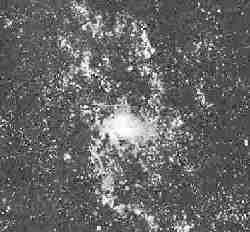V.3 No 1 |
25 |
| Chapter 1. Hypotheses of the Earth origin | |
|
|
V.3 No 1 |
25 |
| Chapter 1. Hypotheses of the Earth origin | |
|
|
Notwithstanding too many discrepancies, the hypothesis of planet group formation from a protoplanet nebula was so tempting that gave rise to a great gamut of developing hypotheses proceeding as from cold as from hot start. We can mention as one of prominent continuations the meteoritic hypothesis by Lord Kelvin. "While Laplace does not indicate the reasons of high temperature which he attributes to the nebula, Lord Kelvin advances back in time and admits existing a cold nebula consisting of separate atoms or meteorite stones, having an initial integer angular momentum, equal or more than that of the entire Solar system. The near-centre collisions will turn the meteoritic mass into gas, this last will spread far behind the Neptune orbit and form the nebula which is needed for the Laplace hypothesis [22]. Here Kelvin goes back in time up to the same primary conditions as Kant, with the except, however, that Kant tries (of course, in vain) to obtain the angular momentum of his system from collisions" [16]. Indeed, to model correct the conditions of planets formation from the protoplanet nebula, one needed to model the premises of protoplanet nebula condensation. Without it many mechanisms suggested by different authors before and after Kant and Laplace lose their grounds. However Lord Kelvin was also inconsistent in his substantiation. In particular, his model of heating the splinters of meteoritic mass raises an important issue of the reasons, how and why in a cold gas nebula appeared this abundance of meteoritic mass in absence of planetary formations? No less important question follows from it - the possibility of so active collision of meteorites that caused not only their fusing but active evaporation in the middle of nebula. Should this last took place in fact, in presence of vast meteoric fields in the today Solar system, we would observe it now (even if in a smaller gauge). One more question follows from this previous. It concerns the meteorites acceleration in their motion to the centre of gas-dust nebula under gravity force. A simple calculation shows that the gravity force falls in approach to the centre of massif body and vanishes in its centre. In fact, beginning with some radius, all internal elements of the nebula are attracted not to its centre but to its surface, if we account the additional centrifugal force resulting from the nebula rotation. O.Yu. Schmidt also adhered to the hypothesis of abundant meteoritic flows, but with the formed Solar nucleus, in the accretion conception which he suggested in 1944 [32]. According to it, "a swarm of meteoritic substance (or gas-dust cloud) having a small mass and spinning with a quite large speed has been captured by a star - Sun - travelling trough it with a large mass and very small angular momentum. The presence of Sun caused an intensive accretion, there originated clots and from them - the planets and satellites (see Fig. 1.7 and 1.8). The 'sun wind' - pressure of sun radiation - took a great part in the system origin.
|
Fig. 1.7. The stages of the Earth and planets origin from a gas-dust cloud, after O.Yu. Schmidt hypothesis [20, Fig. 112, p. 134].
|
a) M51 [33, p. 353] |
 b) M 31 in the Andromeda constellation [20, p. 119, Fig. 100]; |
 c) M 33 in the Triangle constellation [20, p. 120, Fig. 101]; |
Fig. 1.8. Spiral galaxies seen in plan; in such sequence they enable supposing in them different stages of discretisation (condensation) of the protostellar substance, very alike the Schmidt's hypothesis. |
As to the Earth, Schmidt assumed possible its complete melting on the account of thermonuclear reactions that occurred intensively at the early stages of the Sun system evolution. This hypothesis explained much, in particular, the angular momenta paradox" [34, p. 16]. "In the near-Sun regions of the protoplanet cloud, the particles were heated much and their volatile components (solidified light gases) evaporated or, rather, sublimed. So near by the Sun there formed small bodies of refractory elements - Mercury, Venus, Earth, Mars - the Earth-like planets. On the contrary, in the far cold area of the protoplanet cloud, the light elements (initially in a solid, 'frozen' state) remained, so there formed the giant planets Jupiter, Saturn, Uranus, Neptune, consisting mainly of hydrogen and its compositions. At the periphery of protoplanet cloud, where it vanished and where was lack of substance, condensed a small Pluto" [35, p. 38- 40]. Noting the above, we see the obvious discrepancy of such approach. Should the mass of protoplanet swarm was small as to Sun, with the Sun intrusion it would lose its angular momentum, having distributed it into the components and essentially changing the resulting momentum. In this case, the separate meteorites of swarm and their groups can perhaps appear the accretion seeds, but the angular momenta paradox will not be solved so, this is an obvious adjustment. The computations conducted by the students and followers of Schmidt (Levin, Safronov) "showed the probability of such capture quite small, and neither O.Yu. Schmidt nor his adherents could not find a proof that just the capture took place in this case. Today the adherents of O.Yu. Schmidt's hypothesis are inclined to think that the gas-dust protoplanet cloud most likely separated from the shrinking and faster and faster spinning Protosun" [35, p. 40]. Moreover, during last half of century, when direct investigations in space become possible, at the Sun system periphery too many usual planets - the satellites of giant planets - have been discovered, to go on stating the Schmidt's distribution of substance. |
Contents: / 18 / 19 / 20 / 21 / 22 / 23 / 24 / 25 / 26 / 27 / 28 / 29 / 30 / 31 /